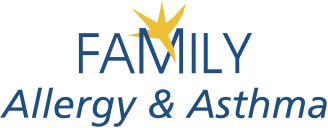Prepare for Ragweed Allergy Season
Fall Allergies & Ragweed Pollen
It seems like summer has just started, but we’ve already spotted weed pollen in our counts, so we know fall allergies are not too far away. Now is the time to prepare. If you usually have fall allergies, it’s essential to begin your allergy medications a few weeks before you typically get symptoms. This pretreatment with antihistamines or nasal sprays can help build up your defense by preventing inflammation before it starts to get out of control.
The fall allergy season also coincides with back-to-school time for many of our patients. This time of year many children head back to the classroom where they are exposed to increased levels of germs and viruses. In addition to ragweed pollen, the cold virus is a trigger for asthma. Our doctors often see a spike in asthma attacks a few weeks after the beginning of school due to the cold virus and fall allergies. Ragweed is just one of the challenging allergens during the fall allergy season.
Ragweed and Other Fall Allergens
Ragweed pollen is well known to cause seasonal allergic rhinitis or hayfever. Ragweed is a weed that produces very fine pollen that generally grows from August through November. Pollen counts for ragweed tend to be highest in mid-September, and those allergic should check pollen counts before planning their day and avoid peak pollen hours.
In general, weeds are the main plants pollinating during the time of year. However, we also see higher levels of mold spores. As leaves begin to fall later in the season, they can compost, keeping mold levels high well into October. Ragweed and other weeds produce pollen until the first frost of the season, usually lasting into October.
Ragweed pollen and mold can cause respiratory allergy symptoms in those who are allergic.
Symptoms of Fall Allergies
Fall allergy symptoms are similar to that of spring allergies, typical symptoms are:
- Sinus Congestion
- Runny Nose
- Post-Nasal Drip
- Sneezing
- Coughing
- Itchy or Watery Eyes
These symptoms are often mistaken for signs of a cold. If your symptoms return year after year during the same months or season, it could be allergies. An allergist is specially trained to diagnose allergies and asthma and can help patients find relief.
Diagnosing & Treating Fall Allergies
The first step of treatment is to find out to what you are allergic by getting allergy tested. Allergy skin testing is the gold standard. During the initial testing appointment appointment, our doctors take a medical history to use along with the skin test to diagnose an allergy. Once we confirm an allergy, our doctors can determine the best treatment options.
The skin test is a series of tiny scratches made on your back. The scratches are conducted with a small instrument similar to a plastic toothpick, which contains trace amounts of a single allergen, such as mold, specific pollens, dust mite, and animal dander. When the results are positive, a small reaction on the skin occurs, usually within 20 minutes. This reaction is generally a small bump, similar to a mosquito bite, and may cause some itchiness. A bump may indicate that you are allergic to that specific trigger, if the testing is inconclusive, additional testing may be completed on the patient’s arm.
Once diagnosed, we recommend avoiding bothersome allergens. When that’s not possible for substances like pollen or dust mites, then we can offer antihistamines and other prescription allergy medications to help manage your symptoms. We often recommend allergy immunotherapy, or allergy shots, for patients with moderate to severe allergies. Unlike antihistamines and nasal sprays, allergy shots treat the underlying cause of allergies and can help patients find longlasting relief.
Fall Seasonal Allergy Tips
Ragweed pollen is difficult to avoid. However, there are a few tips that can help control the pollen and mold spore levels in your home. Here are our tips for those who have fall seasonal allergies:
Control the indoor environment:
- Keep windows closed in the late summer and fall to prevent the outside from coming inside.
- Use HEPA filters in air conditioners or furnaces to keep inside air clean.
- Change air filters with each season, or every three months.
- Use a dehumidifier to control the humidity in damp basements that cause mold.
Prepare when outside:
- Keep an eye on the ragweed pollen and mold counts to prepare for the day.
- Wear a NIOSH N95 mask while outside raking leaves or cleaning gutters.
- Shower after being outside, wash your hair to remove pollen.
- Leave your shoes by the door to prevent tracking pollen and mold inside.
Treat your allergies:
- The first step is to get allergy tested to identify what allergens are causing your symptoms.
- Start your allergy medication at least two weeks before your symptoms usually start.
- Continue taking allergy medication throughout the season.
- If recommended, start immunotherapy to start desensitizing your body to bothersome allergens.
See related: Find Relief from Fall Allergies
Typically, by Halloween we’ve had our first frost which signals the end of the fall allergy season as plant pollen growth is halted. The end of fall is also the time of year people start spending more time indoors. During the colder months, we find our patients have more trouble with indoor allergens like mold and dust mites. Those with fall allergies may start to find relief, however, if you are struggling throughout the season, schedule an appointment with our board-certified allergists. We can help get your allergies back under control.


